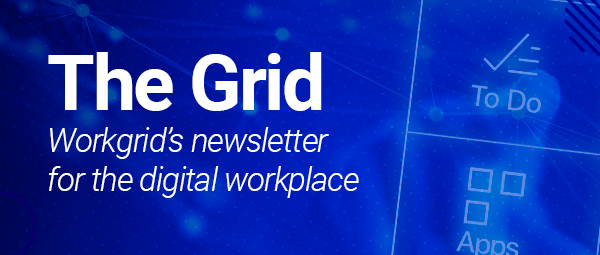Why AI Assistants Have Become an Integral Part of the Modern Workplace
The traditional notion of work is in its final days - infinite repetitive tasks, endless meetings, and aging technology. With the rise of AI, what we're witnessing today is nothing short of a transformation akin to the industrial revolution. However, AI is irrelevant if it is not operationalized and put into the service of employees. This landscape is dramatically changing with the emergence of AI Work Assistants.
These advanced systems are more than mere tools; they represent a seismic shift in how we perceive and execute work. Far from being an incremental upgrade, AI assistants are revolutionizing operational models and offering unprecedented efficiencies. For CIOs and Digital Workplace leaders, this isn't a trend to sit back and observe - it's a call to action. Welcome to a pivotal moment in the evolution of work.
The Role of Search Functionality in Improving Productivity and Efficiency
Born out of a need to digitize the workplace, employees found themselves in a sea of apps and systems seemingly overnight. Log in here for your benefits information. Use this app to access your time off. Implemented with the best intentions, suddenly the tech stack became a hindrance rather than helpful to employees. The result is wasted time context switching and a frustrating employee experience.
Assistants began to boom in conjunction with remote work and as a solution to the digital friction arising from digital transformation. Without the water-cooler conversations or cross-cubicle collaboration, employees needed a resource to help point them in the right direction toward the information they needed.
Traditional search experiences rely heavily on keyword-based search and typically result in a lengthy listing of links which employees then have to spend time reading through to find an answer to their question. In other cases, information is housed in different places so employees must first try to locate the correct system or file location to even begin their search.
Information silos arise naturally as various teams and departments own processes and systems. For example, an employee needs to submit an expense approval. The finance team owns the software, but IT owns access to the system. HR provides the approval policies in a PDF document, but the Internal Comms team hosts this on the company intranet. The employee works in Marketing, and their manager must approve the expense. Five different departments are responsible for unique parts of the process for the employee to complete one simple task, leading to a complicated and confusing experience.
Digital assistants, and their logic-based employee chatbot features, provided workplaces with the first steps toward a better employee experience. But the AI boom brings with it the opportunity for even more intelligent enterprise solutions. A conversational AI Assistant solves for digital friction in the same way a digital assistant or virtual assistant might by helping direct employees to the information they seek out. But in addition to this core functionality, an AI Assistant can incorporate conversational AI features to handle more complex queries. Using natural language processing (NLP), conversational AI Assistants can search for data using APIs across multiple sources at once, leading to more accurate, contextual information, with answers provided in a cohesive response. By leveraging conversational AI, responses from a digital assistant can be more robust, surfacing full sentence responses, microapps, and more, compared to a list of links or basic one-sentence answers.
The Emergence of AI Assistants in the Workplace
A conversational AI Assistant solves digital friction in the same way a digital assistant or virtual assistant might by helping direct employees to the information they seek out. But in addition to this core functionality, an AI Assistant can incorporate conversational AI features to handle more complex queries. Using natural language processing (NLP), conversational AI Assistants can search for data using APIs across multiple sources at once leading to more accurate, contextual information, with answers provided in a cohesive response.
Key Features of an AI Assistant
Unified experience that connects across your systems, documents, and knowledge sources, leveraging Retrieval Augmented Generation and Natural Language Processing to accurately respond to employee requests
Proactive alerts nudge employees with system-based tasks and information including tailored, context-based recommendations and suggestions
Maximized efficiency by simplifying access to systems through integrations and conversation-based triggers that allow employees to complete an array of tasks from expense approvals to ticket submissions in one unified experience
Increased security and minimized phishing attempts by integrating directly with business systems and reducing the likelihood of employees clicking on a scam email
Regulated access to AI by providing an enterprise solution that delivers experiences employees are looking for under the guardrails of established IT practices
![[asset] Effective search and information discovery](https://images.ctfassets.net/z7p73u8c0thn/3w0CT8wg5p4ott4pULDB2x/7450c8fafccd69243343d446a946f953/Effective_search_and_information_discovery.png?w=1200&h=675&q=60&fm=png&bg=transparent)
Traditional Search Methods in the Workplace
Traditional search functionality often relies on keyword-based indexing. But even if more advanced semantic search systems are being deployed, employees still need to know which system to search in – whether it be intranets, knowledge bases, applications, or even email. This results in wasted time sifting through irrelevant search results and multiple clicks to find what they’re looking for.
The difficulties in finding accurate and up-to-date information contribute to information overload and relevance issues. With traditional search, employees cannot quickly review results across multiple knowledge sources and documents simultaneously, and lose productive hours each day, struggling to make timely decisions.
The issue at hand is the scattered nature of information across the business, which creates obstacles for employees who need to quickly and accurately locate the right information. These challenges not only impact employee productivity but also have implications for the business including poor decision making, higher operational costs, and lost revenue.
![[asset] IDC reports search struggles](https://images.ctfassets.net/z7p73u8c0thn/15VusAFQTybgcCX9PHD78B/cda0bcca45dac3f0c151cc574dc7735b/IDC_search_struggles.png?w=1200&h=675&q=60&fm=png&bg=transparent)
Finding relevant information can lead to several challenges for employees such as:
Cognitive overload and fatigue trying to figure out where or what to use to find information
Longer decision making when trying to evaluate results and determine the right answer for you
Context switching costs for employees searching, logging into/out of things, etc.
The Integration of AI Technology in Search Functions
Conversational AI is the term used to describe a range of machine learning and AI capabilities that enables users to have a conversation with their data and systems. NLP and NLU have driven chatbot development for years, but more recent advances with LLMs have enabled a much more dynamic and intelligent experience. Essentially, you have to be able to take any casual or colloquial language and understand the users intent to deliver that meaningful response.
Example question – “how much PTO do I have?”
In this scenario multiple capabilities are used to evaluate the prompt and discern the correct response including:
Intent recognition – identify information that could be in system (how much time have I used?) and policy-based question (how much time am I allowed to take?)
Entity Extraction – understanding that the query is about a person
Enterprise context – information is in a system, which one is it?
RAG – extract a direct answer from multiple sources to the question
![[asset] conversational AI technologies](https://images.ctfassets.net/z7p73u8c0thn/4QhkxaBGgGMX5fAwDU016h/963eada1f1261a5944fe6365835c3f12/Screenshot_2024-06-05_153300.png?w=1200&h=660&q=60&fm=png&bg=transparent)
Conversational AI can interpret natural language queries and generate dynamic responses offering a more interactive and tailored knowledge retrieval experience. It expands the collection of answerable questions from basic FAQs to much more complex queries that require data reasoning and optimizes knowledge retrieval by extracting data across multiple sources.
How AI Assistants Optimize Search to Enhance Workplace Efficiency
Searching for information online is commonplace in our life. Buying a new house? Open the Zillow app. Need to find dinner? Ask Google for restaurants near me. Looking for your latest bank statement? There is an app for that too. In the workplace, we’re also accustomed to searching for the information we need. The problem is, where that information lives is not always intuitive or easy to get to.
Pairing AI alongside enterprise search removes the guess work out of the scenario. Employees don’t have to wonder things like: is this the right folder? Do I have access to this system? Which of these search result links is the right one? Instead, the technology does the legwork, using natural language to understand the intent, searching across multiple sources, and ultimately providing a summarized and contextual answer. Instead of spending hours navigating through documents and systems to find information – which can be an average of 2.5 hours per day, or roughly 30% of the workday, according to IDC – employees can find what they’re looking for and get back to meaningful work.
Another difference between conversational AI and traditional chatbots is tied to how they handle inputs. Chatbots are a type of conversational AI but not all chatbots are conversational AI. Rule based chatbots use keywords and other language identifiers to trigger pre-written responses and are not built on conversational AI technology. This means these types of chatbots are limited in response to what has been added into the chatbot’s rules. Non-conversational AI chatbots require continual maintenance with text-only commands and inputs to remain up to date and effective, while conversational AI uses inputs and sources such as websites, databases, and APIs to learn.
AI also provides an optimized experience by adding an intelligent layer to responses. Functions like enterprise and session context, intent recognition, and sentiment analysis enable conversational AI searches to create a better relationship between a user's intent and the results. By leveraging advanced NLP capabilities and artificial intelligence, conversational AI assistants essentially have a memory and can respond much more contextually in comparison to the historical chatbot experiences of the past.
![[asset] the struggle of decision fatigue](https://images.ctfassets.net/z7p73u8c0thn/58BLokB8Tal2orI9aJ6wCx/e7379a33ae8ff9ebfbeae99ac88c412a/the_struggle_of_decision_fatigue.png?w=1200&h=675&q=60&fm=png&bg=transparent)
Proactive vs Reactive Chat
As is relates to search, traditional bots wait for user input, responding to questions only when prompted. Sure, they can be useful, but this type of bot is hardly transformative. In the modern work environment, these deployments end up being another place to go – adding to mounting digital friction. Thus, reactive chats end up failing to improve the employee experience and instead adding to the digital friction already burdening many organizations.
On the other hand, an AI-powered chatbot, increasingly referred to as an "enterprise copilot," is a paradigm shift in the relationship between the worker and technology. These digital virtuosos actively read the room—your schedules, priorities, and backend workflows—and nudge you with timely insights, tasks, and suggestions.
They don't merely sit around waiting for you to come to them to ask questions; they foresee your needs. They guide your attention where it matters most, streamlining your tasks and preventing potential bottlenecks. In doing so, this is an evolution of being a simple tool to becoming intelligent collaborators.
Contextual Understanding and Intelligent Search Suggestions
Traditional search results often are a jumping off point for the next step – a link to a file, a list of related documents, or a link to another system. But, in most instances, if you are searching for something, you likely want to DO something.
With AI Assistants, the knowledge retrieval experience gets a lot more interactive. With integrations to enterprise systems, not only can these assistants deliver real-time data, they can also perform tasks on a user's behalf such as form filling, ordering, or completing approvals. In addition to these types of integrations, AI Assistants create a more interactive user experience with multimedia integrations, clickable buttons, and contextual understanding.
The following capabilities are just a few examples of how AI can optimize the search experience:
Contraction and Expansion:
Take for example the current experience with Google Search. If a user is looking for a restaurant, they are presented with the option to make a reservation. The ability to combine information with a transaction is also possible in the workplace. If an employee asks an assistant how to order a new computer, they should be directed to place the order instead of being handed a list of employee policy documents to search through.
Keyword and Semantic Search:
Capabilities like keyword and semantic search combine to return results across documents and connected knowledge sources. Once results are returned reranking and reordering is performed based on question and possible responses returned. Removing irrelevant answers so employees see only exactly what they’re looking for.
![[asset] AI Helps Reduce Search Times](https://images.ctfassets.net/z7p73u8c0thn/17dbKGUUtlZSVyYxQeOtHs/cf7bbd53084563e6dd72435a8d625457/Reduce_Search_Times.png?w=1200&h=675&q=60&fm=png&bg=transparent)
The Evolution of AI Assistants and Search Capabilities
One important distinction between chatbots and conversational AI lies in how they acquire knowledge.
Learning chatbots are designed to continuously improve their performance over time. They utilize machine learning algorithms to analyze and understand user input, allowing them to adapt their responses accordingly. These chatbots employ natural language processing techniques to generate meaningful responses. By gathering data from user interactions, they enhance their knowledge and conversational abilities.
In contrast, functional chatbots are focused on completing specific tasks or achieving particular goals. They operate using decision-tree logic and are equipped with predefined algorithms and rules to handle user queries. Their primary purpose is to provide accurate and relevant answers or perform specific tasks, such as customer support, order tracking, or FAQs. Unlike learning chatbots, functional chatbots may not have the ability to learn or adapt their responses based on user interactions. They often require more manual management from the product owner.
As chatbots evolve they will increasingly lean on technologies such as machine learning to deliver more enhanced user experiences.
Integration of External Data Sources Deliver More Comprehensive Results
A powerful feature of AI-integrated knowledge discovery is the use of Retrieval Augmented Generation (RAG). When a user enters a prompt, such as a question about employee benefits, the prompt goes through various processes to deliver the optimum results. This includes augmenting the prompt with context and relevant information before passing it to an LLM. The role of the LLM is to generate a response for the user by synthesizing information from multiple sources – including external sources such as policy documents, employee manuals, and business systems like payroll. Ranking information from the varying sources, the RAG process generates one coherent response to send to the user.
For example, an employee asks what eye care benefits are available. While this question seems fairly straightforward, the query could actually be quite complex. A traditional knowledgebase search might return links to the benefits portal, the employee manual, and an outdated announcement about in-office eye exam. While the employee may find what they’re looking for buried in these links, an AI Assistant can process the question and synthesize an accurate response.
Perhaps the company has offices across the United States and Canada – the correct response to this employee will rely on their location. Perhaps as well there are different types of benefits for salaried and hourly employees. This is a piece of information that may live in a business system rather than a policy document. Additionally, the inquiry may be coming from a new hire, who is actively eligible for benefits enrollment – which may justify a slightly different response than if it were an existing employee.
The Future of Search in the Workplace and It's Impact on Productivity
With the ability to connect and source information from across the workplace, the future of search in the workplace is one that is more intelligent, and more personalized than ever before. With better understanding of the initial question, and more accurate interpretations of the possible answers, employees will be able to find information and act quickly – ultimately resulting in better productivity and more time spent on high value work.
![[asset] reduce information overload with AI](https://images.ctfassets.net/z7p73u8c0thn/2S36LlmKpPTRqimwLmqbza/81cf1bee63d1cde9a4a2b2b6ce411fad/reduce_information_overload.png?w=1200&h=675&q=60&fm=png&bg=transparent)
The evolution of AI assistants will continue to play a role in revolutionizing workplaces from knowledge discovery to the overall employee experience. As workplaces continue to embrace digital platforms, and new technologies are introduced, it’s more important than ever that employees are informed with correct and contextual information that helps them get work done.




